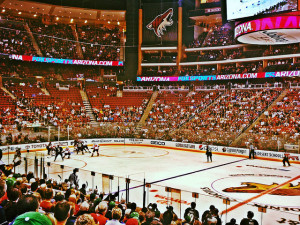 NHL games are no doubt exciting. NHL hockey players’ incredible athletic ability is on display every game. However, it is often the violence inherent in the culture of the game that brings fans to their feet. There is no denying that big hits, checking, and fights sell tickets.
NHL games are no doubt exciting. NHL hockey players’ incredible athletic ability is on display every game. However, it is often the violence inherent in the culture of the game that brings fans to their feet. There is no denying that big hits, checking, and fights sell tickets.
NHL athletes suffer the long-term consequences of this ingrained culture. Like professional athletes in other major sports, NHL athletes play through the pain and get immediate treatment allowing them to return to the ice as soon as possible. When it comes to concussions, NHL players are often never diagnosed or evaluated during games. It is now known that repeated head injuries such those commonly sustained by NHL players can have a cumulative effect resulting in chronic traumatic encephalopathy or CTE.
NHL star Ryan Clowe is just one of many examples of players forced into early retirement due to repeated concussions. The New Jersey Devil can no longer play due to a history of head trauma. His last concussion left him with vision problems, persistent neck pain, and constant headaches.
In 2010 the NHL rewrote Rule 48 and implemented it during the 2010-2011 season. The new rule leveled a five (5) minute game conduct penalty for “late or blindside hits” to an opponent’s head. The new rule also allowed the NHL to mete out additional punishment if it deemed it appropriate under the circumstances. This half-hearted attempt to limit head trauma in the NHL failed to account for the various other ways players sustain concussions. Hits to the head, contact with the boards, and falling to the ice can all cause a player to sustain a concussion. Indeed, the Rule change was a complete failure. A 2013 study authored by Dr. Michael Cusimano concluded that, despite the stiffer penalties, concussion rates in the NHL did not decline.
This season the NHL announced that it will “improve” its concussion spotter program following the NFL protocols employed by the NFL’s “Julian Edelman” rule. The NHL will provide two (2) independent spotters during each game, in addition to the spotters employed by the clubs. The NHL spotters will not have the authority to remove a player from the ice. They will log incidents of concussions and then alert the club of their observations. Only the club trainer can make the decision to remove a player from the ice. In other words, the independent NHL spotters have no power to remove a player from the ice to prevent further injury, something the NFL spotters currently do have.
The NHL is embroiled in litigation with former players over concussions and the damage that violence involved in the game has done to its players. The NHL will drag these players through years of litigation and like the NFL will no doubt claim ignorance about the effects of concussions and repeated head trauma. How the litigation will proceed and whether these players will be able to hold the NHL accountable and obtain compensation and more importantly, medical care for their injuries, will not be known for years.
What is known in 2015 is that diagnosed and undiagnosed concussions happen in the NHL. Repeated sub-concussive hits can cause the same damage over time. We also know that NHL players are five (5) times more likely to suffer a concussion than an NFL player and that one (1) in every three (3) NFL players suffer from disorders and disease of the brain. The average age of an NHL player is 27 and the average career spans 5.5 years. There are 82 games in an NHL regular season. It is not uncommon for an NHL player to have played in over 400 games in his NHL career, not including minor league or junior hockey. Do the math. If real changes are not made, the future of NHL players will be nothing short of grim.
The NHL has been slow to respond and when it has, its decisions have been half-hearted and ineffective. The NHL needs to take control of the game and the decision-making process. When a player shows signs of having sustained a concussion, the spotter must be able to make an independent decision as to whether that player should leave the ice. An independent physician should be available to evaluate the player and in the end, make a reasonable medical decision as to whether that player should return to the ice.
Maybe these changes will affect the outcome of a particular game. However, they will not affect the integrity of the game itself. Indeed, it will instill the type of integrity into professional sports that they have been lacking for some time.
